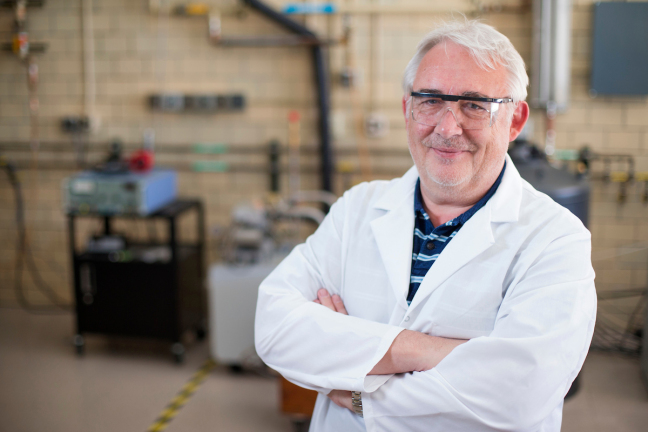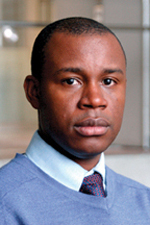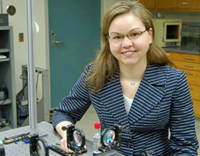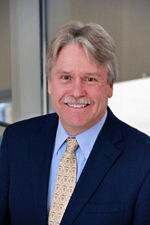
Vitalij Pecharsky is working to develop new refrigeration materials and technologies. He says there are many scientific benefits to the Ames Laboratory's 70 years on the Iowa State University campus. Larger photo. Photo by Christopher Gannon.
AMES, Iowa – Iowa State University and the U.S. Department of Energy’s Ames Laboratory go back 70 years.
It really is a close relationship. The laboratory is located right on the university campus. The doors are open, with people, ideas and expertise moving back and forth. Make a few stops in Spedding, Wilhelm and Gilman halls, plus the Metals Development Building across Pammel Drive, and scientists with a foot in each place can easily count up the benefits.
There’s a wealth of expertise across a research university. There are the many students who work and learn in labs. There’s local access to special instruments and facilities. There’s the chance to work as part of a research team. There’s the opportunity to teach students – and try to keep up with their questions.
It all started on May 17, 1947, when the U.S. Atomic Energy Commission created the lab after Iowa State researchers worked with World War II’s Manhattan Project to develop efficient ways to purify large quantities of uranium for atomic weapons and energy.
These days, the lab is owned by the federal government and operated by Iowa State under a contract with the Department of Energy. The lab has research programs in materials sciences and engineering; critical materials; chemical and biological sciences; materials preparation; simulation, modeling and decision science; and forensic sciences.
Four researchers with joint university-laboratory appointments recently described their current research projects and made observations about the scientific benefits of the Iowa State-Ames Laboratory relationship:
Leafy green refrigeration
Vitalij Pecharsky, an Iowa State Anson Marston Distinguished Professor in Engineering and a senior scientist for the Ames Laboratory, has been in Ames since 1993 and says it’s easy to see the benefits of a national lab on a university campus.
A great example is a project called CaloriCool, Pecharsky said as he picked up a little 3-D printout of the project’s leafy logo.
A member of the Energy Department’s Energy Materials Network, CaloriCool is a research consortium dedicated to designing, discovering and deploying new caloric materials for advanced, solid-state refrigeration. Caloric materials heat up and cool down when they’re subject to mechanical, magnetic or electrical forces. These temperature changes can be harnessed for cooling.
Caloric cooling promises to be more efficient and greener than today’s refrigeration technologies. But Pecharsky said much better caloric materials than those known today are needed to make this a reality.
“If not for Iowa State, we would not be able to bring this into existence,” Pecharsky said. “The university and the laboratory enable us to put together a team with very broad expertise. This will be a substantial part of CaloriCool’s future success.”
Pecharsky, whose research is supported by the Department of Energy, is also studying fuel storage technology for hydrogen vehicles and rare earth materials that have extraordinary reactions to temperature, pressure or a magnetic field.
Most every semester, he also teaches a course to graduate students. Next fall, he’ll teach Materials Science and Engineering 510, Fundamentals of Structure and Chemistry of Materials.
“It’s great fun to work with students, both in class and in a research laboratory,” Pecharsky said. “They always come up with very good questions. They keep you sharp.”
Magnets for the U.S.

Ikenna Nlebedim
Ikenna Nlebedim – an adjunct assistant professor of electrical and computer engineering and associate scientist with the Critical Materials Institute, which is led by the Ames Laboratory – held up a baggie filled with vials containing cobalt, samarium and neodymium powders.
The powders are the result of a new type of recycling that enables reclaiming of critical materials from magnets. Those materials can be recycled back into magnets or other high-end applications.
There are other Department of Energy projects on Nlebedim’s desk: looking at how the United States can launch a domestic magnet industry; studying 3-D printing of high-performance magnets; reducing rare earth materials in magnets by processing them with extreme magnetic fields and temperatures; and developing models to study magnet performance in electric motors, wind turbines and other applications.
He’s also aiding several university-based studies of magnetic materials, including some designed to help companies develop new technologies.
And how do the university and the lab benefit each other?
Here’s one example, Nlebedim said:
“Ames Laboratory provides unique space for students, scientists and professors to collaborate in the study of magnetic materials. Students, including undergraduates, have the opportunity to use this space to learn how to make and characterize these materials. As a result, they can develop the skills they need for their careers while contributing to solving scientifically and industrially relevant problems.”
The national lab way

Emily Smith
Emily Smith’s university office in Gilman Hall is 60 hallway steps from a door into the Ames Laboratory. She says she wouldn’t be at Iowa State if the lab wasn’t so closely tied to the university.
Smith, a professor of chemistry and faculty scientist at the laboratory, specializes in optical spectroscopy. She develops instruments and methods that make it possible to analyze plant cell walls and other systems.
When she was finishing her postdoctoral work at the University of Arizona, she considered a faculty position at Iowa State because a national laboratory is right on campus.
“The way national labs do science is fundamentally different than science at a university,” she said. “National labs support teams of researchers. It’s not single researchers developing their groups and programs.”
Smith is currently working on three team projects through the lab: Studies of next-generation materials for solar cells; development of a new kind of microscope that gives researchers a better look at plant cell walls, the feedstock for advanced biofuels; and combining images from various technologies to give researchers more data to understand plant function.
She also has a university project, funded by the National Science Foundation, to study how proteins in cell membranes move around. That movement allows cells to interact with other proteins and to help the cell sense what’s happening around it. An understanding of the movement could eventually lead to biological and health applications.
Having the Ames Laboratory so close, she said, really makes a difference in her work. The lab brings so many people together, all with different specialties and backgrounds, all doing what they can to advance a common project.
Perfect metal powders

Iver Anderson
Iver Anderson pointed to an oversized image of powdered metal particles that’s posted on the wall outside his office door and began explaining one of his latest and biggest research challenges.
3-D metal printers work by taking metal powders and, depending on the technology involved, melting or binding layer after layer of the metal. The different printing technologies require powders of slightly different sizes for best results.
Anderson – known around the world as the inventor of lead-free solder, work that led to his induction into the National Inventors Hall of Fame earlier this month – is an Iowa State adjunct professor of materials science and engineering and an Ames Laboratory senior metallurgist.
For the past few years, he’s been busy looking for ways to make magnets for the motors in electric and hybrid vehicles without relying on rare-earth materials. But now that the 3-D metal printing industry has grown 20 percent each of the past four years, his metal powder work is also demanding a lot of his attention.
See here, Anderson said as he pointed to the image on the wall, see these bumps and irregularities on some of the round particles? See this one that looks like teddy bear ears? Those are called satellites. We want to eliminate them.
There are other challenges to making perfect metal powders: How do you accurately control particle size for proper flow in a printer? And how do you eliminate formation of hollow particles?
Solve all of that, and 3-D metal printing gets a lot easier and better.
And so Anderson is leading studies of the nozzle and spray technologies that produce the powders. That also means understanding the physics of the temperatures, pressures and velocities in the particle sprays.
Anderson said university-laboratory collaboration is a big boost to that research. First, the university is a source of graduate student and postdoctoral talent. Plus, there’s faculty expertise in the College of Engineering that he’s tapped for assistance.
“If we were at any other national lab and we didn’t have our faculty next-door neighbors, we would not have the horsepower for these projects,” Anderson said. “We’re able to draw on the talent pool of Iowa State. And faculty here are ready and willing to work with us on these major projects.”
